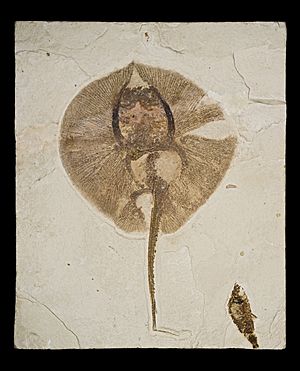Heliobatis facts for kids
Quick facts for kids Heliobatis |
|
|---|---|
 |
|
| Male Heliobatis radians fossil | |
| Scientific classification | |
| Kingdom: | |
| Phylum: | |
| Class: | |
| Order: | |
| Family: |
Dasyatidae
|
| Genus: |
Heliobatis
|
| Species: |
H. radians
|
| Binomial name | |
| Heliobatis radians Marsh, 1877
|
|
| Synonyms | |
|
|
Heliobatis was an extinct type of stingray. It lived a very long time ago. Today, we only know about one species from this group, called Heliobatis radians.
This ancient ray is famous for its amazing fossils. These fossils are found in a special place called Fossil Lake. This area is part of the Green River Formation in southwest Wyoming, USA.
Contents
Discovering Heliobatis
Heliobatis was first described in 1877. A scientist named Othniel Charles Marsh gave it its name. The name Heliobatis means "sun ray." This might be because of its round, flat body shape.
Where Heliobatis Lived
The fossils of Heliobatis are found in rocks from the early Eocene period. This time was about 56 to 34 million years ago. During the Eocene, the Earth was much warmer than it is today.
The Green River Formation was once a huge system of freshwater lakes. These lakes were home to many different animals and plants. Heliobatis lived in these ancient lakes. This is interesting because most stingrays today live in the ocean.
A Rare Find
Heliobatis is quite special. It is one of only two types of rays ever found in the Green River Formation. The other ray found there is called Asterotrygon maloneyi. Scientists first learned about Asterotrygon maloneyi in 2004. Finding two different kinds of rays in the same ancient lake system helps scientists learn about how these animals evolved.
Fossils of Heliobatis
The fossils from the Green River Formation are incredibly well-preserved. This means we can see many details of the ancient animals. For Heliobatis, we can often see its whole body shape. We can even see its long tail and the outline of its fins.
These fossils help us understand what life was like millions of years ago. They show us that freshwater lakes were once home to creatures like stingrays. Studying these fossils helps scientists learn about Earth's past environments. It also teaches us about the history of life on our planet.
Images for kids


